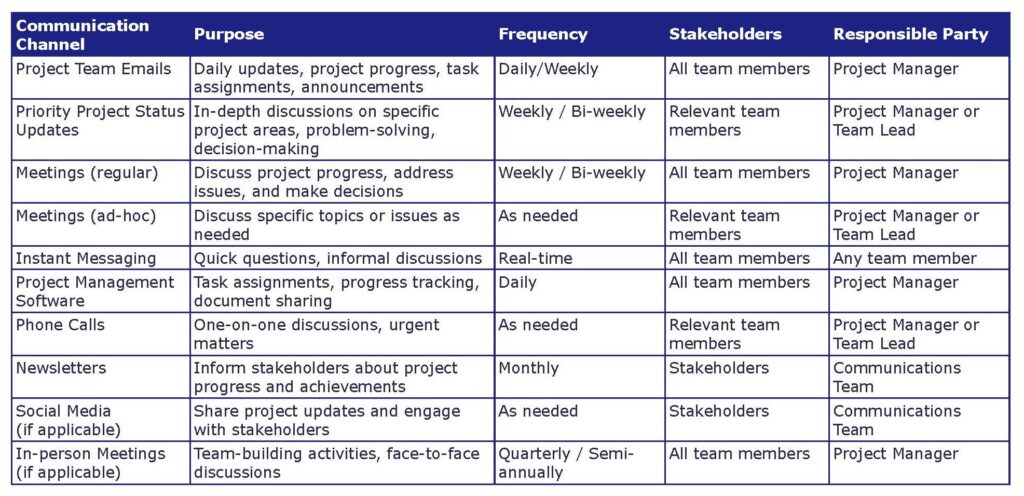Introduction
Ever wondered why some projects seem to run smoothly while others are plagued by miscommunication and persistent delays? The answer often lies in the quality of the project team’s communication plan. A well-crafted communication plan is the cornerstone of successful project management, ensuring that everyone is on the same page, working towards a common goal, and minimizing misunderstandings.
Understanding the Purpose of a Communication Plan
Think of a communication plan as the roadmap that guides your project team through the journey to success. It outlines how information will be shared, decisions will be made, and challenges will be addressed. A well-defined communication plan ensures that:
- Everyone is informed: All team members have access to the information they need to do their jobs effectively.
- Misunderstandings are minimized: Clear communication channels and protocols help prevent confusion and errors.
- Collaboration is enhanced: A shared understanding of goals and expectations fosters teamwork and collaboration.
- Decision-making is streamlined: Efficient communication processes enable timely and informed decision-making.
- Stakeholders are kept engaged: Regular communication with stakeholders builds trust and support.
By investing time and effort into creating a comprehensive communication plan, you can set your project up for success and avoid the pitfalls of poor communication.
Key Components of a Project Team Communication Plan
A comprehensive communication plan is essential for ensuring effective collaboration and project success. To create a successful plan, carefully consider the following key components:
Communication Goals
- Define specific objectives: Clearly outline what you want to achieve through your communication plan. Consider factors such as improving information flow, building trust, resolving conflicts, and ensuring everyone is on the same page.
- Set measurable targets: Establish quantifiable goals to track the effectiveness of your communication efforts. For example, you might aim to reduce the number of misunderstandings by 20% or increase employee satisfaction by 15%.
Stakeholder Analysis
- Identify key stakeholders: Determine who has a stake in the project’s success and their level of interest and influence.
- Understand their communication needs: Identify how each stakeholder group prefers to receive information and how often they want to be updated.
- Tailor your communication: Develop communication strategies that address the specific needs and expectations of each stakeholder group.
Communication Channels
- Consider various options: Choose from a variety of communication channels, such as email, meetings, instant messaging, project management software, and face-to-face meetings.
- Select appropriate channels: Determine the most suitable channels for different types of information. For example, use email for routine updates, meetings for in-depth discussions, and instant messaging for quick questions or announcements.
Communication Frequency
- Determine appropriate frequency: Decide how often you need to communicate with different stakeholders and during different project phases.
- Consider project complexity, team size, and stakeholder expectations: Factors such as project complexity, team size, and stakeholder expectations will influence the frequency of communication.
Communication Protocols
- Establish guidelines: Set clear guidelines for communication, such as response times, meeting schedules, and reporting formats.
- Ensure understanding: Make sure everyone on the team understands and follows these protocols.
- Review and update regularly: Periodically review and update your communication protocols to ensure they remain relevant and effective.
Crisis Communication Plan
- Develop a plan: Create a plan for handling unexpected situations or crises.
- Define roles and responsibilities: Clearly define who is responsible for communicating during a crisis and what their specific roles are.
- Practice and test your plan: Conduct drills and simulations to ensure that your team is prepared to respond effectively to a crisis.

Tips for Effective Communication
Effective communication is crucial for building strong relationships, fostering collaboration, and achieving project goals within your project team. By implementing the following tips, you can enhance communication and create a more productive and positive work environment.
Encourage active listening among team members by providing opportunities for feedback and discussion. When listening, avoid interrupting, maintain eye contact, and demonstrate that you’re paying attention. Show empathy by understanding the speaker’s perspective and responding thoughtfully.
Use clear and concise language to avoid misunderstandings. Tailor your communication style to different audiences, considering their knowledge level, preferences, and cultural background. Avoid jargon or technical terms that may confuse others.
Pay attention to nonverbal cues, as they can convey important messages. Maintain eye contact, use open body language, and modulate your tone of voice to reinforce your message and build trust. Pay attention to your body language and how it might be interpreted by others.
Establish mechanisms for resolving conflicts and disagreements. Encourage open and honest communication during conflict resolution and avoid blaming or making accusations. Focus on finding mutually beneficial solutions and building relationships.
Challenges and Best Practices
Effective communication within project teams can be hindered by various challenges, including language barriers, cultural differences, time zone differences, overreliance on technology, and lack of clarity and consistency. To overcome these obstacles and ensure effective communication, consider the following strategies:
Establish clear communication protocols. Define expectations for communication, such as response times, meeting schedules, and reporting formats. This will help to ensure that everyone is on the same page and knows what is expected of them.
Invest in training and support. Offer training on communication skills and provide ongoing support to help team members communicate effectively. This can include training on active listening, nonverbal communication, and cultural sensitivity.
Utilize a variety of communication channels. To reach all team members and accommodate different preferences, use a combination of communication channels, such as email, instant messaging, video conferencing, and face-to-face meetings.
Foster a culture of open and honest communication. Create an environment where team members feel comfortable sharing their thoughts and concerns without fear of judgment or reprisal. This can be achieved by setting a positive example as a leader, fostering a supportive environment, and providing opportunities for feedback.
By implementing these strategies, you can overcome common communication challenges and ensure that your project team is well-equipped to collaborate effectively and achieve its goals.
Conclusion
A well-defined communication plan is essential for the success of any project. By following the strategies outlined in this article, you can improve communication within your project team, build stronger relationships, and achieve your project goals. Remember to regularly review and update your project team communication plan to ensure it remains effective as your project progresses.


